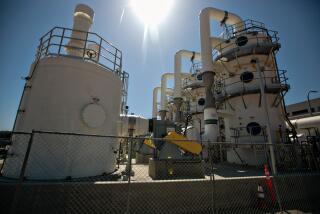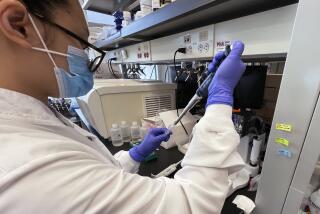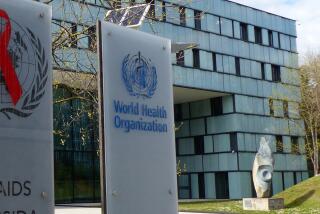U.S. system to detect bioterrorism can’t be counted on, government watchdog finds
Reporting from Washington — The nation’s main defense against biological terrorism — a $1-billion network of air samplers in cities across the country — cannot be counted on to detect an attack, according to a new report by the Government Accountability Office.
The BioWatch system, introduced with fanfare by President George W. Bush in 2003, has exasperated public health officials with numerous false alarms, stemming from its inability to distinguish between harmless germs and the lethal pathogens that terrorists would be likely to unleash in an attack.
Timothy M. Persons, the GAO’s chief scientist and lead author of the report, said health and public-safety authorities “need to have assurance that when the system indicates a possible attack, it’s not crying wolf.” U.S. Homeland Security officials cannot credibly offer that assurance, he said.
NEWSLETTER: Get the day’s top headlines from Times Editor Davan Maharaj >>
“You can’t claim it works,” Persons said in an interview.
The Department of Homeland Security, which oversees BioWatch, has repeatedly touted the system’s effectiveness while seeking to upgrade it with new technology.
The GAO report challenges the department’s central claims about BioWatch. It also illuminates the nation’s vulnerability to biological terrorism at a time of heightened concern about the reach and resourcefulness of Islamic State and other extremist groups.
The 100-page document, scheduled for release Monday, says that Homeland Security “lacks reliable information” about BioWatch’s “technical capabilities to detect a biological attack.” The Los Angeles Times obtained a copy of the report.
The government has never defined the minimum capabilities, or “performance requirements,” needed for BioWatch to alert authorities to a deliberate release of deadly pathogens and not be fooled by similar but benign bugs that are pervasive in the environment, according to the report.
Homeland Security officials “told us that in the 12 years since BioWatch’s initial deployment, they have not developed technical performance requirements against which to measure the system’s ability to meet its objective,” the report says.
In defending the system, the department cited computer simulations and tests in which biological agents were released in sealed chambers. The GAO said those tests were insufficient to support “conclusions about the system’s ability to detect attacks.”
BioWatch has not been put to the ultimate test of a real-life attack.
In a response appended to the GAO report, a senior Homeland Security official, Jim H. Crumpacker, wrote that bioterrorism “remains a continuing threat to the security of our nation” and that BioWatch is the only “biosurveillance system designed to detect the intentional release” of airborne pathogens.
“The program provides public health officials with a warning of potentially hazardous biological agent release before exposed individuals would typically develop symptoms of illness,” Crumpacker wrote. He added, “It is important to recognize levels of uncertainty and limitations are inherent in any complex technical system.”
BioWatch relies on about 600 air-collection units stationed atop buildings, in transit stations and in other public places in more than 30 urban areas. Mobile units are deployed at some major spectator events, such as the Super Bowl.
Each of the units, about the size of a small refrigerator, sucks in air and blows it over a disposable filter. Once every 24 hours, a technician removes the filter and delivers it to a public health lab for analysis. Lab personnel look for a DNA match with anthrax or any of four other pathogens considered likely to be used in a biological attack.
BioWatch was developed by U.S. national laboratories and government-hired contractors. Its deployment was accelerated after anthrax-laced letters were sent through the U.S. mail in the fall of 2001, infecting more than 20 people and killing five. The letters were ultimately traced to a U.S. Army scientist, Bruce E. Ivins, who committed suicide in 2008 as authorities prepared to seek an indictment against him.
The GAO study was requested by members of Congress after a 2012 Los Angeles Times investigation identified serious shortcomings in BioWatch, including the many false alarms and doubts about whether the system could be relied on to detect an actual attack.
The false alarms threatened to disrupt the 2008 Democratic National Convention in Denver, the 2004 Super Bowl in Houston and the 2006 National League baseball playoffs. In 2005, a false alarm in Washington prompted officials to consider closing the National Mall.
In each of those cases, public health authorities decided to disregard the BioWatch alert, sometimes after hours of tense deliberations.
Most of the false alarms have involved mistaken detection of the bacterium that causes tularemia, also known as rabbit fever, which can be fatal. BioWatch appeared to have been fooled by close cousins of the tularemia germ that pose no danger to humans, according to scientists familiar with the system.
The GAO report contradicts public statements by Homeland Security officials that the erroneous alerts were not “false positives.” Those officials, in defending BioWatch, had said the system did detect something in the environment, even if it turned out to be innocuous.
The report says that from 2003 through 2014, BioWatch generated 149 mistaken detections — all of which “have been termed false positives” by scientists at the U.S. Centers for Disease Control and Prevention and other experts the GAO consulted. The frequency of false alarms has declined since 2013, the report says.
BioWatch has cost taxpayers $87 million over the last year, the report says. It recommends against spending more money to maintain the system in its present form, even though the air collectors and other equipment are wearing out.
One possibility is to switch to an automated system, an approach that Homeland Security and a major defense contractor, Northrop Grumman Corp., have long pursued. Earlier this year, the department sought information from potential contractors about such a changeover.
The GAO report suggests that such a step would be premature because Homeland Security “lacks reliable information” to make “informed cost-benefit decisions about upgrades.”
Richard H. Ebright, a Rutgers University professor of chemistry and chemical biology who has focused on bioterrorism policy, said the current system is beyond salvaging.
“BioWatch has devolved into little more than a program for channeling funds from taxpayers to contractors,” Ebright said by email. “The correct solution is to start afresh.”
ALSO
Five Syrian asylum seekers surrender at Texas border crossing
New York City’s schools debate removing metal detectors
U.S. intelligence: No specific threat to Thanksgiving travel after Paris attacks
More to Read
Sign up for Essential California
The most important California stories and recommendations in your inbox every morning.
You may occasionally receive promotional content from the Los Angeles Times.











